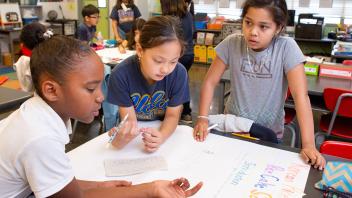Young children benefit from opportunities to read a rich array of fiction and informational books. Reading educators and researchers agree that young children benefit from increased exposure to informational books (Snow, Burns, & Griffin, 1998). Today there is an abundance of high-quality informational text for teachers and parents to use with children. According the Cooperative Children’s Book Center (2006), the number of informational books published for the early grades has increased by 200% over the last ten years.
An early preference for nonfiction?
Several recent research studies by Pappas (1993) and Mohr (2006) suggest that children in kindergarten and first-grade often prefer to read nonfiction books. However, by the time students reach fourth grade, where they are expected to read and learn from informational text and content area textbooks, there is an overall decline in reading scores (Chall, Jacobs, & Baldwin, 1990). These findings suggest that greater exposure to informational texts during the early years may help minimize the effects of the “fourth grade slump” in reading achievement.
Informational text and reading achievement
Evidence that reading informational texts increases reading achievement can be found in data from the National Assessment of Educational Progress (NEAP). From 1990 to the present, the trends on the NAEP indicate that fourth graders’ reading achievement increases as the diversity of their reading experiences increases. Fourth graders who reported reading a wide variety of text (e.g., narrative, informational) had higher reading achievement than students who reported reading only one type of text. Therefore, it seems reasonable that exposing young children to informational text will help them to handle the literacy demands of their later schooling (Duke & Bennett-Armistead, 2003).
Instructional techniques for informational text
Several practical instructional techniques can be used to promote understanding and enjoyment of informational texts. These instructional techniques familiarize children with the language and structures of non-fiction books. We agree with David Pearson (2003) who reminds us that proficiency with informational text helps students build the skills they need to be successful in school, work, and community.
In the following sections we describe three instructional methods:
- Text Impression
- Guiding Questions
- Retelling Pyramid
Text Impression (McGinley & Denner, 1987) is an effective way to introduce vocabulary and hold predictive discussions before reading. Guiding Questions (Marinak & Mazzoni, 2008) set a purpose during reading, and the Retelling Pyramid (Schwartz & Bone, 1995) supports retelling and summarization after reading. Examples of the three techniques are described below using examples from the popular book Wild Babies by Seymour Simon.
Before Reading: Text Impression
Before reading, it’s important to introduce new vocabulary and activate prior knowledge about the topic. The Text Impression technique invites children to share what they know and motivates them to begin reading. To conduct a Text Impression, 5-10 important vocabulary words are shared one by one. With each word added to the list, children are invited to hone their predictions based on the important vocabulary.
Below is a Text Impression taken from Wild Babies. Note that by end of the Text Impression, children can predict that the reading will most likely be about penguins and an African animal that lives in a herd. The fun word that might provide surprise is ‘kindergarten.’ Readers might not be aware that penguins and giraffes both protect their young in ‘kindergartens.’
- Antarctic
- African
- One
- Rookery
- Herd
- Kindergarten
During Reading: Guiding Questions
Guiding Questions can be provided to set a purpose for reading. It is important that the inquiry include literal questions, inferential questions, and extended questions. In addition, the questions should include some of the important vocabulary introduced in the Text Impression. The Q-Matrix by Spencer Kagan is helpful when writing challenging Guiding Questions. The Q-Matrix contains question stems to construct all three types of questions.
In addition to teachers using the Q-Matrix to write Guiding Questions, students can also use the matrix to write their own questions. Below are several Guiding Questions for the giraffe and penguin in Wild Babies. Each question uses the word ‘kindergarten’ from the Text Impression. The stem words from the Q-Matrix are in bold.
Literal Questions
- How long do penguin chicks stay in a kindergarten?
- How old is a giraffe calf when they enter a kindergarten?
Inferential Question
- When would penguins and giraffes form kindergartens?
Extended Question
- Giraffes and penguins use kindergartens to protect their young. What might other animals do to protect their babies?
After Reading: Retelling Pyramid
A Retelling Pyramid can be used after reading. The pyramid supports retelling and summarization. The prompts for each line of the pyramid can be revised to reflect specific information from the text. Below is an example of Retelling Pyramid with prompts from Wild Babies. After completing the pyramid, children can compare and contrast the giraffe and the penguin.
Conclusion
These three simple instructional techniques can be used with young children to make informational text more interesting and accessible. The use of these techniques will support children in developing the language, strategies and skills needed to read informational materials with greater ease. As children become more competent in their ability to comprehend informational text, they will be more motivated to choose to read informational texts.
